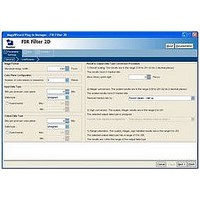IPSR-VIDEO Altera, IPSR-VIDEO Datasheet - Page 50

IPSR-VIDEO
Manufacturer Part Number
IPSR-VIDEO
Description
RENEWAL Of IPS-VIDEO
Manufacturer
Altera
Series
IP Suitesr
Datasheet
1.IPS-VIDEO.pdf
(202 pages)
Specifications of IPSR-VIDEO
Software Application
IP CORE, SUITES
Supported Families
Arria GX, Cyclone II, HardCopy II, Stratix II
Features
Common Avalon Streaming (Avalon-St) Interface And Avalon-St Video Protocol
Core Architecture
FPGA
Core Sub-architecture
Arria, Cyclone, Stratix
Rohs Compliant
NA
Lead Free Status / RoHS Status
na
- Current page: 50 of 202
- Download datasheet (6Mb)
3–14
Table 3–13. Deinterlacer Parameter Settings (Part 3 of 3)
Frame Buffer
Table 3–14. Frame Buffer Parameter Settings (Part 1 of 2)
Video and Image Processing Suite User Guide
Read-only master(s)
interface FIFO depth
Read-only master(s)
interface burst target
Write-only master(s)
interface FIFO depth
Write-only master(s)
interface burst target
Base address of frame
buffers
Align read/write bursts
with burst boundaries
Notes to
(1) Either double or triple-buffering mode must be selected before you can select the weave or motion-adaptive deinterlacing methods.
(2) These options are available only when you select Motion Adaptive as the deinterlacing method.
(3) The options to align read/write bursts on burst boundaries, specify the Avalon-MM master ports width, and the base address for the frame
(4) The option to synchronize input and output frame rates is only available when double-buffering mode is selected.
(5) The options to control the buffering of non-image data packets are available when you select double or triple-buffering.
(6) You cannot enable both run-time control interfaces at the same time.
(7) This MegaCore function does not support interlaced streams where fields are not of the same size (eg, for NTSC, F0 has 244 lines and F1 has
(8) The weave and motion-adaptive algorithms stitch together F1 fields with the F0 fields that precede rather than follow them.
(9) NTSC video transmits 60 interlaced fields per second(30 frames per second). Selecting an Output frame rate of As input frame rate ensures
(10) The total memory required at the specified base address is displayed under the base address.
Maximum image width
Maximum image height
Bits per pixel per color plane
Number of color planes in sequence
Number of color planes in parallel
Frame dropping
Frame repetition
buffers are available only when you select double or triple-buffering.
243 lines). Altera recommends that you use the clipper MegaCore function to crop the extra line in F0.
that the output is 30 frames per second.
Parameter
(3) (10)
Table
Parameter
3–13:
(3)
Table 3–14
16–1,024, Default = 64
2–256, Default = 32
16–1,024, Default = 64
8–256, Default = 32
Any 32-bit value,
Default = 0x00000000
On or Off
shows the Frame Buffer parameters.
Value
32–2600,
Default = 640
32–2600,
Default = 480
4–20, Default = 8
1–3
On or Off
On or Off
1–3
Value
Choose the FIFO depth of the read-only Avalon-MM interface.
Choose the burst target for the read-only Avalon-MM interface.
Choose the FIFO depth of the write-only Avalon-MM interface.
Choose the burst target for the write-only Avalon-MM interface.
Hexadecimal address of the frame buffers in external memory
when buffering is used.
Turn on to avoid initiating read and write bursts at a position that
would cause the crossing of a memory row boundary.
Specify the maximum frame width.
Specify the maximum frame height. In general, this value
should be set to the full height of a progressive frame.
However, it can be set to the height of an interlaced field for
double-buffering on a field-by-field basis when the support
for interlaced inputs has been turned off.
Choose the number of bits per pixel (per color plane).
Choose the number of color planes in sequence.
Choose the number of color planes in parallel.
Turn on to allow frame dropping.
Turn on to allow frame repetition.
Description
Description
January 2011 Altera Corporation
Chapter 3: Parameter Settings
Frame Buffer
Related parts for IPSR-VIDEO
Image
Part Number
Description
Manufacturer
Datasheet
Request
R

Part Number:
Description:
CYCLONE II STARTER KIT EP2C20N
Manufacturer:
Altera
Datasheet:

Part Number:
Description:
CPLD, EP610 Family, ECMOS Process, 300 Gates, 16 Macro Cells, 16 Reg., 16 User I/Os, 5V Supply, 35 Speed Grade, 24DIP
Manufacturer:
Altera Corporation
Datasheet:

Part Number:
Description:
CPLD, EP610 Family, ECMOS Process, 300 Gates, 16 Macro Cells, 16 Reg., 16 User I/Os, 5V Supply, 15 Speed Grade, 24DIP
Manufacturer:
Altera Corporation
Datasheet:

Part Number:
Description:
Manufacturer:
Altera Corporation
Datasheet:

Part Number:
Description:
CPLD, EP610 Family, ECMOS Process, 300 Gates, 16 Macro Cells, 16 Reg., 16 User I/Os, 5V Supply, 30 Speed Grade, 24DIP
Manufacturer:
Altera Corporation
Datasheet:

Part Number:
Description:
High-performance, low-power erasable programmable logic devices with 8 macrocells, 10ns
Manufacturer:
Altera Corporation
Datasheet:

Part Number:
Description:
High-performance, low-power erasable programmable logic devices with 8 macrocells, 7ns
Manufacturer:
Altera Corporation
Datasheet:

Part Number:
Description:
Classic EPLD
Manufacturer:
Altera Corporation
Datasheet:

Part Number:
Description:
High-performance, low-power erasable programmable logic devices with 8 macrocells, 10ns
Manufacturer:
Altera Corporation
Datasheet:

Part Number:
Description:
Manufacturer:
Altera Corporation
Datasheet:

Part Number:
Description:
Manufacturer:
Altera Corporation
Datasheet:











